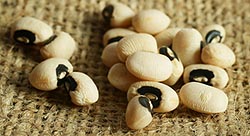Black-eyed Beans Nutrition Facts
Black-eyed beans are also called black-eyed peas. Originally native to Africa, but widely grown in many countries in Asia, the black-eyed bean was introduced into the West Indies and from there to the Southern United States as early as the 1600s in Virginia. Most of the black-eye bean cultivation in the region, however, took firmer hold in Florida and the Carolinas during the 1700s, reaching Virginia in full force following the American Revolution.
Black-eyed beans are rich in soluble fiber which helps to eliminate cholesterol from the body. They are a good source of folate, potassium, copper, phosphorous and manganese. As a high- potassium, low-sodium food they help reduce blood pressure. Not only are they low in fat, but when combined with grains, beans supply high quality protein which provides a healthy alternative to meat or other animal protein. Beans also contain protease inhibitors which frustrate the development of cancerous cells. potassium, low-sodium food they help reduce blood pressure. Not only are they low in fat, but when combined with grains, beans supply high quality protein which provides a healthy alternative to meat or other animal protein. Beans also contain protease inhibitors which frustrate the development of cancerous cells.
Black-eyed beans have a smooth texture, pea-like flavor and are good when mixed with other vegetables.
|